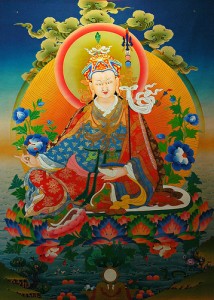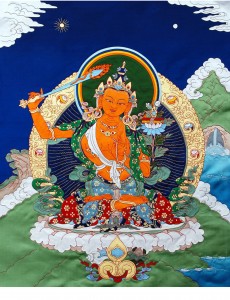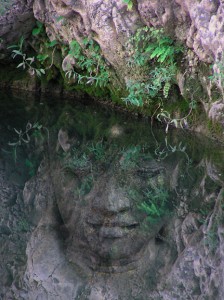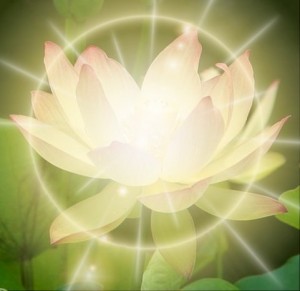
An excerpt from a teaching called Awakening from Non-Recognition by Jetsunma Ahkon Lhamo
This relationship between the student and teacher absolutely depends on the connection between what appears to be two things. On the part of the teacher, the relationship requires the capability to express, display and communicate Dharma, and certainly the intention of Bodhicitta first and foremost. The student’s well-being and realization, recognition, awakening, enlightenment is the goal of the relationship. The teacher’s responsibility is to connect with the student in order to bring about that result and to provide all of the necessary components on the path in order to achieve that result.
What is the student’s responsibility? The student’s responsibility is not to treat this relationship as an ordinary thing, once you have determined that it is not of the world. That would be inappropriate. Have you ever seen children make collages? They take a piece of construction paper and they glue pretty sparkled things on that piece of paper and then they give it to mom. They just make a play-pretty. That’s their artistic endeavor because they can paste and glue. You don’t think students do that with their teacher? The equivalent would be to take a most precious jewel, like the Hope Diamond, exquisitely precious, immeasurable in worldly and monetary terms, put some Elmer’s glue on it and stick it on a piece of paper right next to all the fuzzy things and play-pretties and sparkles and colored macaronis and all the things kids use to make collages, and say “Because I can paste and glue. Because I’m six years old now and I can do this.” That would be the equivalent. You would take that precious jewel and paste it on that piece of paper and just throw it around with the other things you make because you can, because you’re smart, because you’re human, because you’re American. Can you see what I’m saying here?
This precious relationship should not be dealt with in that way. It’s absurd. You cringe when you think of a diamond—that’s worth so much money that it could probably feed all the homeless in our entire country for at least a period of time—used as a play thing, pasted on construction paper with colored macaroni and stuff. It’s exactly the equivalent of practicing Guru Yoga in the way that we practice it.
That precious relationship provides a format in which we practice recognizing. When we are born in samsara we have a certain experience. As a human being we are born of a mother and a father. You can’t get away from that. As far as I know, no one has just appeared somewhere. If you have, please tell me. I want to see that you’re missing a belly button. We pass through the birth canal and we experience the world as infants and then we grow into consciousness. There seems to be this continuum that expresses itself in time. Why does that happen? Well, it’s because we believe self-nature to be inherently real. Self-nature is not the same as the Buddha nature. It has a certain kind of limitation, and the format seems to be that it moves through space. It takes place in space. To take place in space you need to take place in time also. So we have this experience and we take it for granted. That’s simply the way it is.
The Buddha is able to look at you and see everything about you, every single condition that brought you to this present moment. What kind of perception is that? When the Buddha looks at this experience, the Buddha sees in awareness, in the awakened state. In that recognition there is something else. There is an appearance of this nature in a display form, like the sun’s rays coming from the sun. The Buddha understands this nature and does not distinguish between this and that, between empty and full, between high and low, between hot and cold, between solid and non-solid. The Buddha recognizes that face, that nature, that ground-of-being simply in emanation form.
When we meet with our teacher, there is a different relationship, and this is how we have to understand the necessity and power of Guru Yoga. If you have chosen your teacher correctly, the teacher is a Bodhisattva with enough wisdom, enough awareness, and enough accomplishment in meditation so that there is recognition, so that the teacher knows your nature. The teacher recognizes this potential, this seed, and the teacher/student relationship is completely based on that recognition. Even though the teacher may occasionally interface with a student in a way that appears to be ordinary, it’s always about bringing the relationship full circle until the student’s recognition occurs. That is the basis of the relationship. Don’t make it ordinary. It’s not about a warm fuzzy. It’s not about being comfy cozy. It’s not about feeling good. It’s not about whether we both like to ice skate or have the same color skin. It’s not about any of that.
It’s about the appearance and the recognition of that appearance. The student has an incredible opportunity and that is to begin to practice entering into a state of recognition, utilizing the Guru Yoga, utilizing the teacher. Why should we utilize the teacher rather than sit down and chant “Om” and just meditate and see if we can recognize our natural state? Well, because it’s not likely to happen that way, that’s why.
We are ordinary sentient beings lost in samsara. We have been conceptualizing self-nature since time out of mind. We have unbelievably strong habitual tendencies. If you think addiction is strong, as it appears in the world now with drugs and alcohol, it’s nothing compared to the level of addiction to a habitual tendency that we have in our clinging to ego as being inherently real. It doesn’t even come close!
In this relationship we are going to conceive of something different. We are going to determine what is ordinary and what is extraordinary. We are going to go through this whole process we’ve outlined. We determine that this relationship is extraordinary. It arises from the Buddha nature. It results in the Buddha nature. In the middle is the path or the method. This being the case, we begin to understand that if this relationship arises from the Buddha nature and it is the Buddha nature and that is our nature, when we see the teacher, we have at last seen our own face. That precious moment—when that face that is our nature arises in some way that we can recognize—is the beginning of recognition.
Now it seems external. It seems like the teacher is out there. It is the student’s responsibility to practice in such a way that they begin to recognize this appearance as the most precious, holy experience. It’s not like worshiping a statue. It’s not like that. It’s recognition of the nature. What is the nature? It is the Buddha nature, indistinguishable from our own nature, therefore the recognition of our true face.
We talk about how to see our teacher when we meet him or her for the first time during the day. There are practices and beautiful writings—I myself have even written things about this and spoken about this, but it’s not my particular talent. In our heart without pride, with surrender, with beauty, with gentleness, with regard, without rigidity, without ideas, without taking that jewel and putting it on that collage, on that piece of paper, we behold the teacher and we say, “This is my heart, my mind, my breath. All that is precious and holy to me, all that is beautiful in this world.” And we place the teacher in our practice above the crown of our head. Are we stupid people worshiping something else? Are we kind of limp or weird? Are we maybe not American anymore? Try to understand. This is not about a personality cult. This is not about putting one being or body or personality above any other. It’s not like that. This is about recognition. The same pride, confusion and preconceived ideas that cause us to say, “Well, I just don’t know. This person is just an ordinary person and maybe I should just be friendly and try to do some practice and some reading.” That kind of holding oneself back from recognition is the exact same holding oneself back from recognition that is occurring right now to you and causes you to remain suffering in samsara. If you insist upon putting the teacher in the ordinary category, you insist upon putting the nature in an ordinary category. It’s the same problem, the same habit, the same disease.
© Jetsunma Ahkon Lhamo


![velcro[1]](https://www.tibetanbuddhistaltar.org/wp-content/uploads/2010/09/velcro1-300x237.gif)



![buddha5ascetics28[1]](https://www.tibetanbuddhistaltar.org/wp-content/uploads/2010/09/buddha5ascetics281-234x300.jpg)
